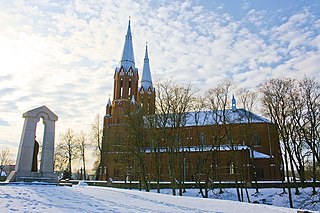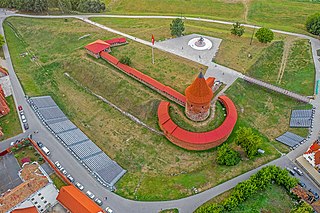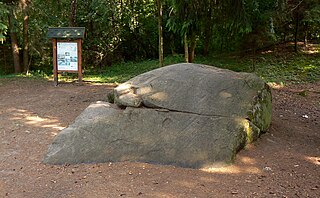
Lithuania, officially the Republic of Lithuania, is a country in the Baltic region of Europe. It is one of three Baltic states and lies on the eastern shore of the Baltic Sea. Lithuania shares land borders with Latvia to the north, Belarus to the east and south, Poland to the south, and Russia to the southwest. It has a maritime border with Sweden to the west on the Baltic Sea. Lithuania covers an area of 65,300 km2 (25,200 sq mi), with a population of 2.8 million. Its capital and largest city is Vilnius; other major cities are Kaunas and Klaipėda. Lithuanians belong to the ethno-linguistic group of the Balts and speak Lithuanian, one of only a few living Baltic languages.

Kaunas is the second-largest city in Lithuania after Vilnius and an important centre of Lithuanian economic, academic, and cultural life. Kaunas was the largest city and the centre of a county in the Duchy of Trakai of the Grand Duchy of Lithuania and Trakai Palatinate since 1413. In the Russian Empire, it was the capital of the Kaunas Governorate from 1843 to 1915.

Utena County is one of ten counties in Lithuania. It is the country's most sparsely populated county. The capital and the largest city in the county is Utena, which is 95 km (59 mi) from Vilnius, the capital of Lithuania. On 1 July 2010, the county administration was abolished. Since that date, Utena County remains as the territorial and statistical unit.

Old Prussians, Baltic Prussians or simply Prussians were an indigenous tribe among the Baltic peoples that inhabited the region of Prussia, at the south-eastern shore of the Baltic Sea between the Vistula Lagoon to the west and the Curonian Lagoon to the east. The Old Prussians, who spoke an Indo-European language now known as Old Prussian and worshipped pre-Christian deities, lent their name, despite very few commonalities, to the later, predominantly Low German-speaking inhabitants of the region.

Jonas Mekas was a Lithuanian-American filmmaker, poet, and artist who has been called "the godfather of American avant-garde cinema". Mekas' work has been exhibited in museums and at festivals worldwide.

The coat of arms of Lithuania is a mounted armoured knight holding a sword and shield, known as Vytis. Since the early 15th century, it has been Lithuania's official coat of arms and is one of the oldest European coats of arms. It is also known by other names in various languages, such as Waykimas, Pagaunė in the Lithuanian language or as Pogonia, Pogoń, Пагоня in the Polish, and Belarusian languages. Vytis is translatable as Chase, Pursuer, Knight or Horseman, similar to the Slavic vityaz. Historically – raitas senovės karžygys or in heraldry – raitas valdovas.

Ašvieniai are divine twins in the Lithuanian mythology, identical to Latvian Dieva dēli and the Baltic counterparts of Vedic Ashvins. Both names derive from the same Proto-Indo-European root for the horse – *ék̂wos: Old Lithuanian ašva and Sanskrit ashva mean "horse". Like the Greek Dioscuri Castor and Pollux, they are reflexes of a common Indo-European mytheme, the Divine Twins.

Dołęga is a Polish coat of arms. It was used by several szlachta families in the times of the Polish–Lithuanian Commonwealth.
Battle of Kyiv or Battle ofKiev may refer to:

Šilutė is a city in the south of the Klaipėda County in western Lithuania. The city was part of the Klaipėda Region and ethnographic Lithuania Minor. Šilutė was the interwar capital of Šilutė County and is currently the capital of Šilutė District Municipality.

Anykščiai District Municipality is one of 60 municipalities in Lithuania.

Birštonas is a balneological resort and a spa town in Lithuania situated 30 km (19 mi) south of Kaunas on the right bank of the Nemunas River. Birštonas received its city rights 1529, and was appointed a city in 1966. The city is the administrative centre of the Birštonas municipality.

Kaunas Castle is a medieval castle in Kaunas, the second-largest city in Lithuania. Archeological evidence suggests that it was originally built during the mid-14th century, in the Gothic style. Its site is strategic – a rise on the banks of the Nemunas River near its confluence with the Neris River. At the beginning of the 21st century, about one-third of the castle was still standing.

The Centras Eldership is an Eldership in the city of Kaunas, Lithuania, based on two neighbourhoods of Kaunas - the Old City and the New City. It lies at the confluence of two major Lithuanian rivers, the Nemunas and the Neris. The borough borders Žaliakalnis in the north, Šančiai in the east, Aleksotas in the south and Vilijampolė in the west.

Anykščiai Regional Park covers 15,485 hectares in northeastern Lithuania near the city of Anykščiai. It was founded in 1992 to preserve natural and cultural areas.
Litvin is a Slavic word for residents of Lithuania, which was used no earlier than the 16th century mostly by the East Slavs. Currently, Litvin or its cognates are used in many European languages for Lithuanians.
This page is based on this
Wikipedia article Text is available under the
CC BY-SA 4.0 license; additional terms may apply.
Images, videos and audio are available under their respective licenses.













